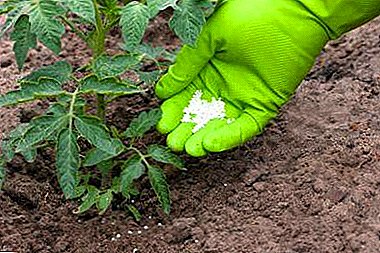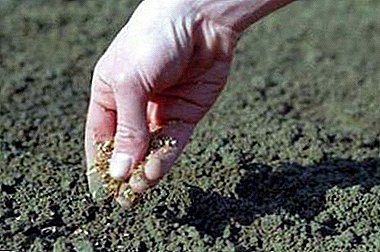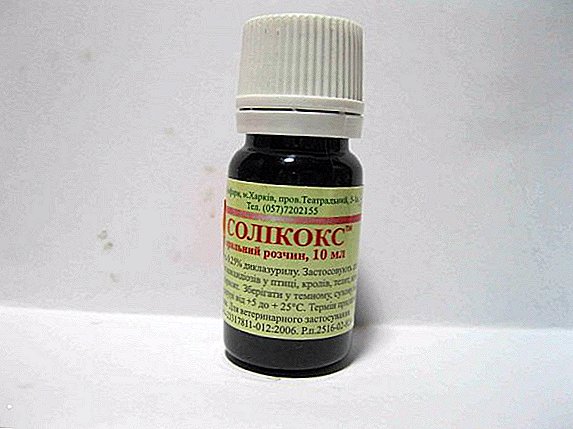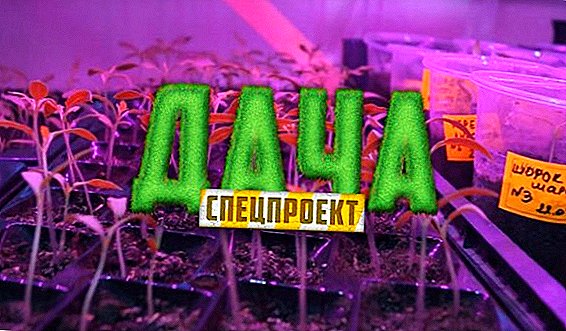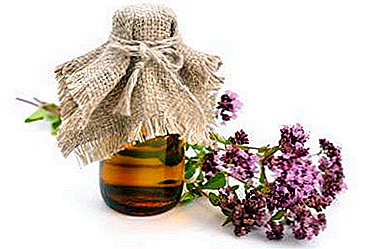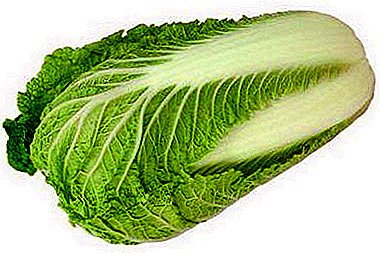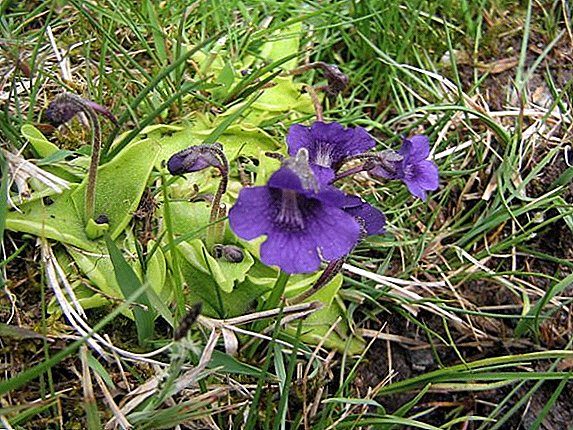 The plant, which will be discussed in this article, for many countries is rare. Zhiryanka belongs to the endangered species of flora and is protected by law. Legal protection of this herb has been adopted in Slovakia, Hungary, Poland, Germany, Ukraine, Lithuania and Latvia. In order to understand more about the life of the wild Zhyryanka, about its types and names, read our notes.
The plant, which will be discussed in this article, for many countries is rare. Zhiryanka belongs to the endangered species of flora and is protected by law. Legal protection of this herb has been adopted in Slovakia, Hungary, Poland, Germany, Ukraine, Lithuania and Latvia. In order to understand more about the life of the wild Zhyryanka, about its types and names, read our notes.
Zhyryanka ordinary (Pinguicula vulgaris L.)
Zhiryanka ordinary is a perennial herbaceous plant of the genus Zhiryanka, family Bubyl.
Important! Unlike other plants of the Bubyl family, all species of Zhyryanka have real roots. However, an important condition for the growth of zhiryanka are optimal weather conditions. Otherwise, the plant forms a very weak root, which easily rots.
Habitat: wet cliffs and cliffs in subalpine areas, wetlands and wet soil in mountainous areas.
Spread: Europe, Greenland, Iceland, Scandinavia, Alaska.
Bloom: June August.
 Description: the plant has fibrous roots (5-15 cm). The height of the grass is 5-25 cm. The leaves are basal (basal, sessile), located at the base, 2-5 cm long, 1-2 cm wide. It is easy to recognize common fat to be found in broad, pear-shaped, yellowish-green, and also sticky and slimy to the touch leaves. Stems erect and long (5-17 cm tall). Calyx has a hairy structure. Single inflorescence. Petals have a bluish-purple color. Observation of the leaves revealed numerous tiny insects and small debris that seemed to stick to the surface of the leaf. Common zhiryanka and all other varieties of this plant are propagated by seed.
Description: the plant has fibrous roots (5-15 cm). The height of the grass is 5-25 cm. The leaves are basal (basal, sessile), located at the base, 2-5 cm long, 1-2 cm wide. It is easy to recognize common fat to be found in broad, pear-shaped, yellowish-green, and also sticky and slimy to the touch leaves. Stems erect and long (5-17 cm tall). Calyx has a hairy structure. Single inflorescence. Petals have a bluish-purple color. Observation of the leaves revealed numerous tiny insects and small debris that seemed to stick to the surface of the leaf. Common zhiryanka and all other varieties of this plant are propagated by seed.
Important! If you decide to engage in the cultivation of Zhyryanka in your garden or at home, it is important to know that this plant is a parasite (insectivorous). StickyIsh Zyryanka - this is a kind of trap for insects. Water and special minerals contained in the leaves attract small insects. When insects gather on the grass surface, the leaves roll from the edge to the center and eat the insects.
Alpine Toast (Pinguicula alpina L.)
Alpine zhiryanka - a single plant, has a relatively long life expectancy.
Description: in contrast to common Zhyryanka, the pedicel of this plant is slightly shorter. Rhizome stem, brown; adventitious roots are pale yellow with one rosette of leaves at the base. Plant height - 5-15 cm. The leaves are alternate, located at the base, 4-5 in one outlet, up to 4 cm in diameter, have sticky glands on the surface. The color of the leaves varies from yellowish green and dark red to pink. A single alpine white suhale flower is white with yellow pollen.
Distribution and habitat: The plant is very thermophilic. Occurs on southern slopes and rocks in the middle arctic zone. Alpine zhiryanka is a European and Siberian kind of zhiryanki, widely distributed in the northern and highland areas.
Bloom: usually one new bud opens during one season.
Did you know? Unlike other species, alpine zyryanka is a semi-parasite. The plant has chlorophyll and also receives nutrients from photosynthesis.
Gypsum Toaster (Pinguicula gypsicola)
Description: the rhizome is simple, short, but there are many adventitious filiform roots. Numerous basal leaves have a ciliary structure and oblong-wedge-shaped or blunt shape (1.5-8 cm in length, 2-3.5 mm in width). Pedicle erect; the flower has a characteristic purple hue. The corolla is divided into upper and lower lips; petals purple. The diameter of the corolla is from 2 to 2.5 cm.
 Distribution and habitat: Mexico is the birthplace of the plant, also found in Brazil. This type of Zhyryanka was first found and investigated in 1910 near a gypsum quarry located in San Luis (1300 m above sea level). In 1991, got its name and began to be cultivated in Europe. The habitat of gypsum zhiryanka requires a more detailed description. A typical environment for this plant is rocky hills: grass grows either in crystalline crevices or in thin layers of diffuse soil.
Distribution and habitat: Mexico is the birthplace of the plant, also found in Brazil. This type of Zhyryanka was first found and investigated in 1910 near a gypsum quarry located in San Luis (1300 m above sea level). In 1991, got its name and began to be cultivated in Europe. The habitat of gypsum zhiryanka requires a more detailed description. A typical environment for this plant is rocky hills: grass grows either in crystalline crevices or in thin layers of diffuse soil.
It prefers a more shaded side of the hill, facing north or north-west, since there the evaporation of water from the soil is less and the temperature is lower. However, sometimes the plant can be found in the shady places of small canyons. During the dry season (from December to June), the plant receives moisture only from morning mists. Between August and November, there are more regular rains, but the hill itself also retains moisture, which provides the plant with additional feeding.
Bloom: from June to November (depending on soil moisture); bloom may begin later.
Toaster round-split (Pinguicula cyclosecta)
Zhiryanka round-split - the simplest kind of Zhiryanka.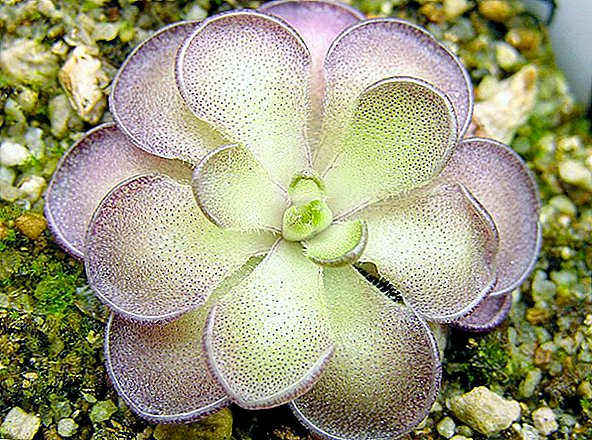
Description: it differs from other species in round, pale green sessile leaves. Numerous leaves are collected in a dense outlet. The outlet diameter is 20 cm, the length of the pedicle is 12 cm. The rim is very fragile, purple in color. Rhizome short, simple, with a lot of adventitious filiform roots. This herb needs minerals. Therefore, like many types of Zhyryanka, this plant uses its leaves as Velcro to trap insects (in order to supplement poor nutrition).
Spread: Mexico is the birthplace of Zhiryanka roundness. In the wild, perennial grows in forests: on limestone rocks and tree trunks. Sometimes it grows in areas with a lot of mosses or simply on cracks in the rocks (on the north side of the rocks).
Moranian toast (Pinguicula moranensis)
Zyryanka Moranskaya - perennial insectivorous plant. 
Description: in summer, the plant forms a basal rosette of leaves up to 10 centimeters in length, which are covered with mucous glands. Like other species, the Moranian zhiryanka feeds on insects. Nutrients extracted from the flesh of small arthropods are used in addition to the existing nutrients in the soil. In winter, Moranian zhiryanka loses its outlet and takes the form of a small predatory plant. The flower has a pink or purple shade, located on a vertical stem up to 25 cm long. The plant blooms twice a year.
Distribution and habitat: This species was first found in Mexico in 1799. To this day, the plant grows in Mexico, as well as in Guatemala. Moranian toast is widely cultivated throughout the world.
Did you know? Of all the species of the genus Zhiryanka, the most popular for cultivation in the home is the fatfish Moran. This is partly due to the fact that the plant has large, light, thin and very colorful leaves.
Zhiryanka flat-leaf (Pinguicula planifolia)
Description: zhiryanka flat leaves from other species are distinguished by a deep maroon leaf color. Some samples may have lighter colors (due to insufficient sunlight). The outlet diameter is 12.5 cm; pedicel height - 12 cm. The flat leaf fat flower has five petals. The color of the petals varies from pinkish-purple to almost white. The flowers are small, but can reach 2 cm in diameter. For the flower to fully open its petals, the plant needs bright sunlight for several days. It is in sunlight that the leaves of the grass acquire a deep red color.
 Habitat: This kind of fatty woman likes a very wet habitat. Flat plate can be found in such wet areas as slopes, marshes, wet meadows.
Habitat: This kind of fatty woman likes a very wet habitat. Flat plate can be found in such wet areas as slopes, marshes, wet meadows.
Spread: widespread in the northern hemisphere. This type of Zhiryanka comes from the USA (southeast part); often found in france.
Flowering period: March to April, depending on temperature.
Threats: the plant is threatened with draining the site, deteriorating water quality and all kinds of human activity.
Zyryanka Wallisnerielistnaya (Pinguicula vallisneriifolia)
The fat-claret valleus is another type of insectivorous plants belonging to the Bubyllate family.
Distribution and habitat: plant lives in rocky areas and limestone zones at an altitude of 600-1700 meters above sea level. Perennial grass loves moist, but protected areas from direct precipitation. Zhirinka vallysenelistnaya is widespread in the mountains of Spain.
Description: the flower is pale pink or purple, less often white or pale blue. The corolla petals have a length of 15-22 mm. Basal leaves have a diameter of 12.5 cm, height 12 cm; the color of the outlet is terracotta,
Flowering period: Common Wall vegetal blossom usually blooms in May or early June.
Cultivation: long-term cultivation will be a difficult task. The necessary conditions for growth are: good humidity, low temperature and a UV lamp.
Zhirianka nitelist (Pinguicula filifolia)
Zyryanka zylelistnaya - perennial plant, another insectivorous subspecies of the genus Zyryanka.
Spread: Zyryanka nitylistnaya covers a wider ecological zone than other species. It occurs mainly in the western part of Cuba and in some neighboring regions. Zyryanka nitelist was first discovered in 1866.
Habitat and ecology: Zyryanka filamentous grows near coastlines and in marshes. Grass flourishes in the swamps with high temperature and high humidity of air and soil. However, the dry season, which lasts from November to April, this plant withstands adequately.
Description: the length of the leaves of Zhiryanka filamentous - 4-6 mm, width - 1-1,5 mm. Like most other fat plants, this tropical plant uses its sticky secretions on the leaves to catch small insects, pollen and other plant debris to supplement its own nutrition. The socket has a diameter of 8-10 mm. One outlet usually has 4-6 blades. Each flower consists of 5 petals. The color of the petals varies from white to yellow, from blue to purple.
Bloom: the flowering period occurs mainly in the summer season (July, August), but the plant can bloom all year round.
Threats: due to constant staying in the swamp, fat stalker often faces the threat of rotting. When fatty tissue reaches mature growth, leaf blades take a vertical position. This upright position helps her avoid rotting and fungal diseases.
Diuple violet (Pinguicula ionantha)
Zyryanka violet is a rare species of flowering plants of the Bubyllate family.
Description: This perennial herbaceous insectivorous plant forms a rosette of bright green leaves with fleshy edges. The leaves, each up to 8 centimeters in length, are covered with sticky hairs. The flower is pale purple. The corolla has greenish spurs on the back. The center of the flower is covered with yellow or red hairs. The corolla lobes have white hairs.
Bloom periodI: February-April.
Habitat: grass is widespread in the USA. It grows in swamps, deep swamps, wet depressions and puddles. In many countries, the fatty herb violet is counted as an endangered species. A threat to the plant are forest fires. In addition, a prolonged drought is able to reduce the number of plants.
Did you know? Even nAfter heavy rains, being under water for several days, the fatty herb violet is able to survive.
Crystal fatfish (Pinguicula crystallina)
FCrystal White - the last plant on our list from the genus Zhiryanka.
Features: a mature plant has from six to nine thin light green leaves (from 1.5 cm to 3 cm in length and 1 cm in width). The shape of the leaves varies from elongated to ovate-oblong. The flower has a whitish blue or pink hue. The rim can be up to 2 cm in diameter.
Distribution and habitat: Cyprus is considered to be the birthplace of the plant, but historical records prove that for the first time the crystal lard was discovered on the territory of modern Turkey. The plant is also found in southern Italy, in Bosnia and Herzegovina, Albania, and Greece. Crystal Zhirin prefers limestone cliffs, stone walls, as well as swamps or wet meadows. Cultivate this species is not easy. The plant is exposed to frost and snow.
Did you know? Until 1991, Pinguicula crystallina and Pinguicula hirtiflora were considered two separate species. However, repeated studies were conducted. Analyzes have shown that these two plants are very closely related and should not be considered as two different species. Now Pinguicula hirtiflora is no longer a separate species, it is a subspecies of Zhiryanka crystal.
Few people in our country are familiar with fat. Now, however, if you ever happen to meet this wild and bewitching grass with its beauty, you can easily recognize it, and you may even wish to grow it on your windowsill.


